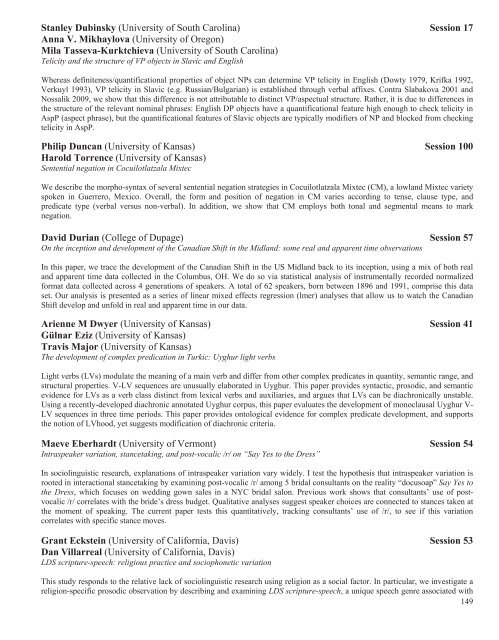here - Linguistic Society of America
here - Linguistic Society of America
here - Linguistic Society of America
You also want an ePaper? Increase the reach of your titles
YUMPU automatically turns print PDFs into web optimized ePapers that Google loves.
Stanley Dubinsky (University <strong>of</strong> South Carolina) Session 17Anna V. Mikhaylova (University <strong>of</strong> Oregon)Mila Tasseva-Kurktchieva (University <strong>of</strong> South Carolina)Telicity and the structure <strong>of</strong> VP objects in Slavic and EnglishW<strong>here</strong>as definiteness/quantificational properties <strong>of</strong> object NPs can determine VP telicity in English (Dowty 1979, Krifka 1992,Verkuyl 1993), VP telicity in Slavic (e.g. Russian/Bulgarian) is established through verbal affixes. Contra Slabakova 2001 andNossalik 2009, we show that this difference is not attributable to distinct VP/aspectual structure. Rather, it is due to differences inthe structure <strong>of</strong> the relevant nominal phrases: English DP objects have a quantificational feature high enough to check telicity inAspP (aspect phrase), but the quantificational features <strong>of</strong> Slavic objects are typically modifiers <strong>of</strong> NP and blocked from checkingtelicity in AspP.Philip Duncan (University <strong>of</strong> Kansas) Session 100Harold Torrence (University <strong>of</strong> Kansas)Sentential negation in Cocuilotlatzala MixtecWe describe the morpho-syntax <strong>of</strong> several sentential negation strategies in Cocuilotlatzala Mixtec (CM), a lowland Mixtec varietyspoken in Guerrero, Mexico. Overall, the form and position <strong>of</strong> negation in CM varies according to tense, clause type, andpredicate type (verbal versus non-verbal). In addition, we show that CM employs both tonal and segmental means to marknegation.David Durian (College <strong>of</strong> Dupage) Session 57On the inception and development <strong>of</strong> the Canadian Shift in the Midland: some real and apparent time observationsIn this paper, we trace the development <strong>of</strong> the Canadian Shift in the US Midland back to its inception, using a mix <strong>of</strong> both realand apparent time data collected in the Columbus, OH. We do so via statistical analysis <strong>of</strong> instrumentally recorded normalizedformat data collected across 4 generations <strong>of</strong> speakers. A total <strong>of</strong> 62 speakers, born between 1896 and 1991, comprise this dataset. Our analysis is presented as a series <strong>of</strong> linear mixed effects regression (lmer) analyses that allow us to watch the CanadianShift develop and unfold in real and apparent time in our data.Arienne M Dwyer (University <strong>of</strong> Kansas) Session 41Gülnar Eziz (University <strong>of</strong> Kansas)Travis Major (University <strong>of</strong> Kansas)The development <strong>of</strong> complex predication in Turkic: Uyghur light verbsLight verbs (LVs) modulate the meaning <strong>of</strong> a main verb and differ from other complex predicates in quantity, semantic range, andstructural properties. V-LV sequences are unusually elaborated in Uyghur. This paper provides syntactic, prosodic, and semanticevidence for LVs as a verb class distinct from lexical verbs and auxiliaries, and argues that LVs can be diachronically unstable.Using a recently-developed diachronic annotated Uyghur corpus, this paper evaluates the development <strong>of</strong> monoclausal Uyghur V-LV sequences in three time periods. This paper provides ontological evidence for complex predicate development, and supportsthe notion <strong>of</strong> LVhood, yet suggests modification <strong>of</strong> diachronic criteria.Maeve Eberhardt (University <strong>of</strong> Vermont) Session 54Intraspeaker variation, stancetaking, and post-vocalic /r/ on “Say Yes to the Dress”In sociolinguistic research, explanations <strong>of</strong> intraspeaker variation vary widely. I test the hypothesis that intraspeaker variation isrooted in interactional stancetaking by examining post-vocalic /r/ among 5 bridal consultants on the reality “docusoap” Say Yes tothe Dress, which focuses on wedding gown sales in a NYC bridal salon. Previous work shows that consultants’ use <strong>of</strong> postvocalic/r/ correlates with the bride’s dress budget. Qualitative analyses suggest speaker choices are connected to stances taken atthe moment <strong>of</strong> speaking. The current paper tests this quantitatively, tracking consultants’ use <strong>of</strong> /r/, to see if this variationcorrelates with specific stance moves.Grant Eckstein (University <strong>of</strong> California, Davis) Session 53Dan Villarreal (University <strong>of</strong> California, Davis)LDS scripture-speech: religious practice and sociophonetic variationThis study responds to the relative lack <strong>of</strong> sociolinguistic research using religion as a social factor. In particular, we investigate areligion-specific prosodic observation by describing and examining LDS scripture-speech, a unique speech genre associated with149
















